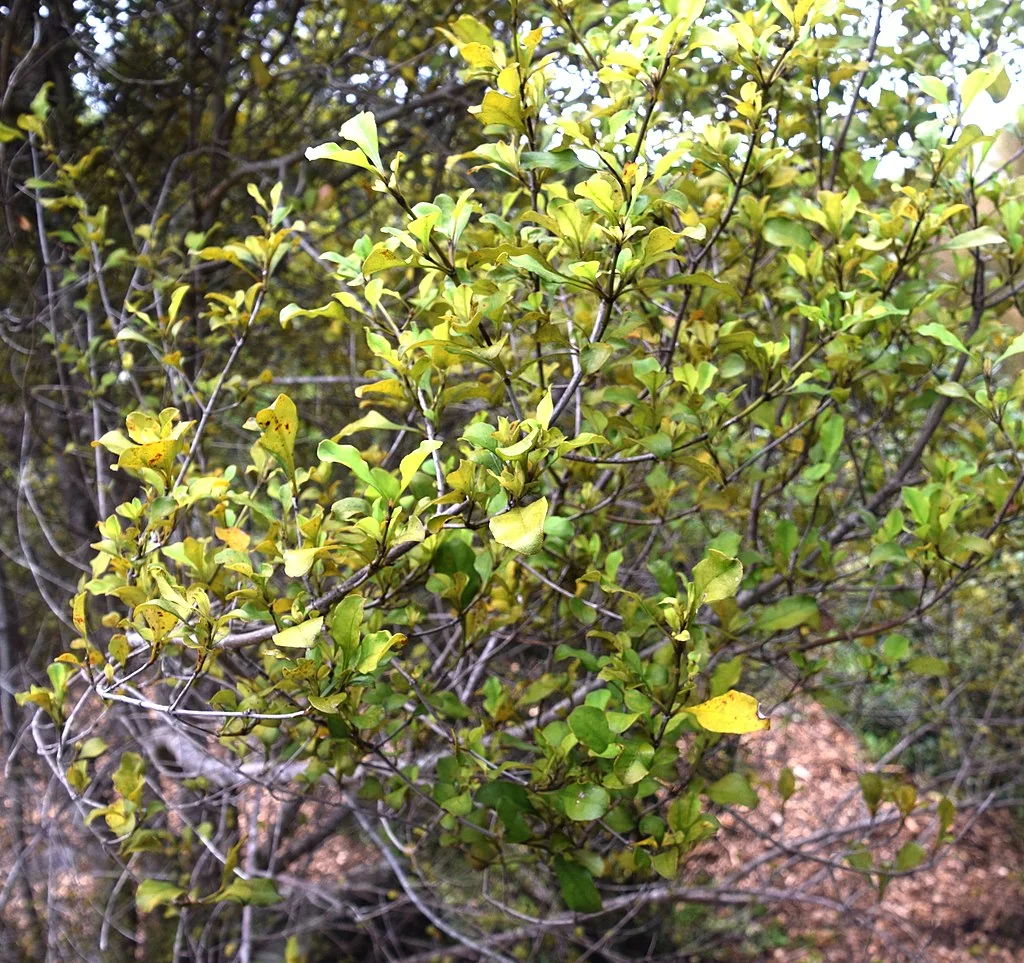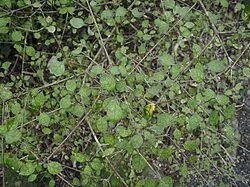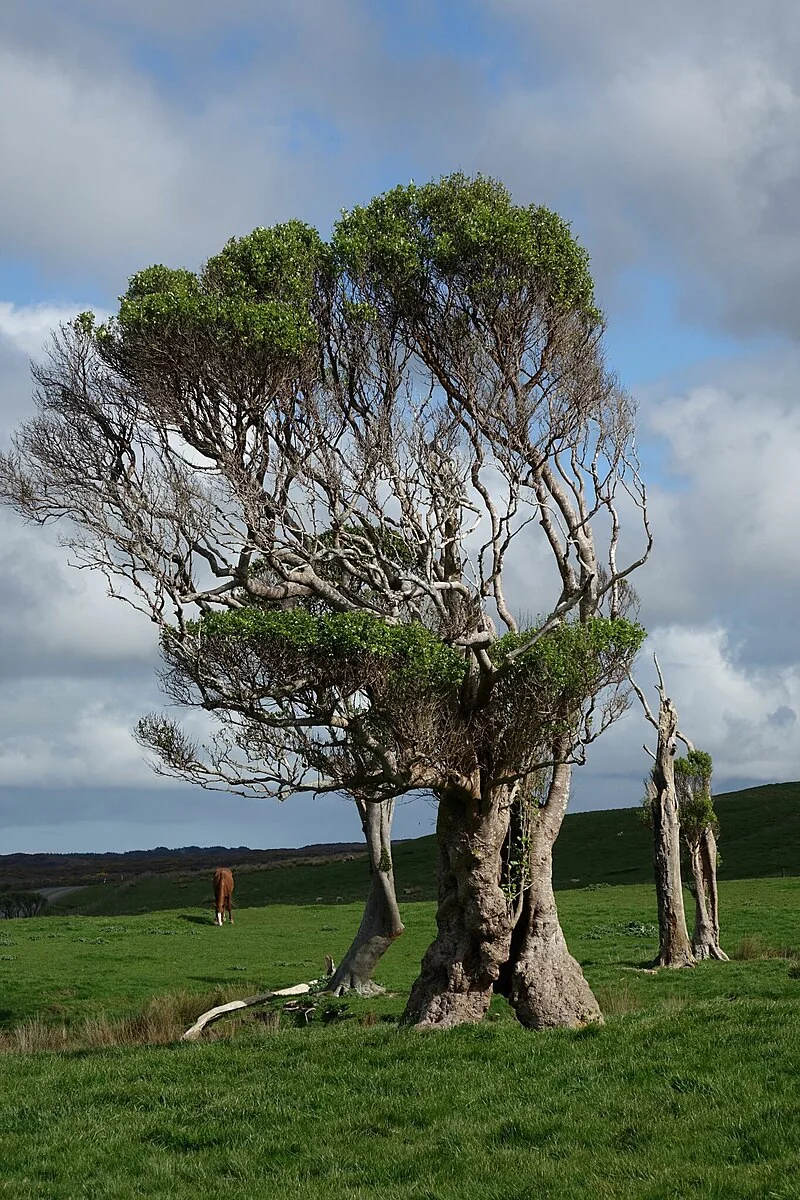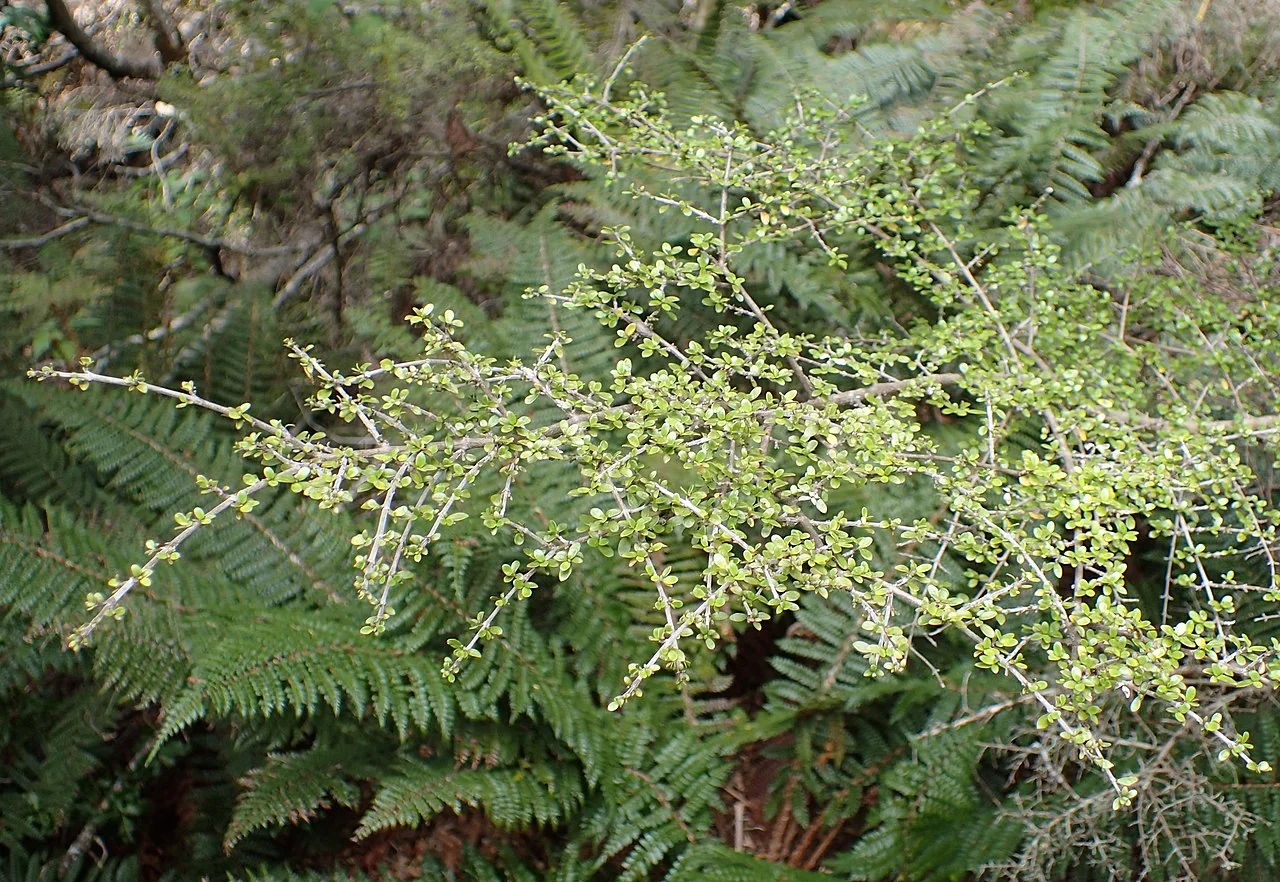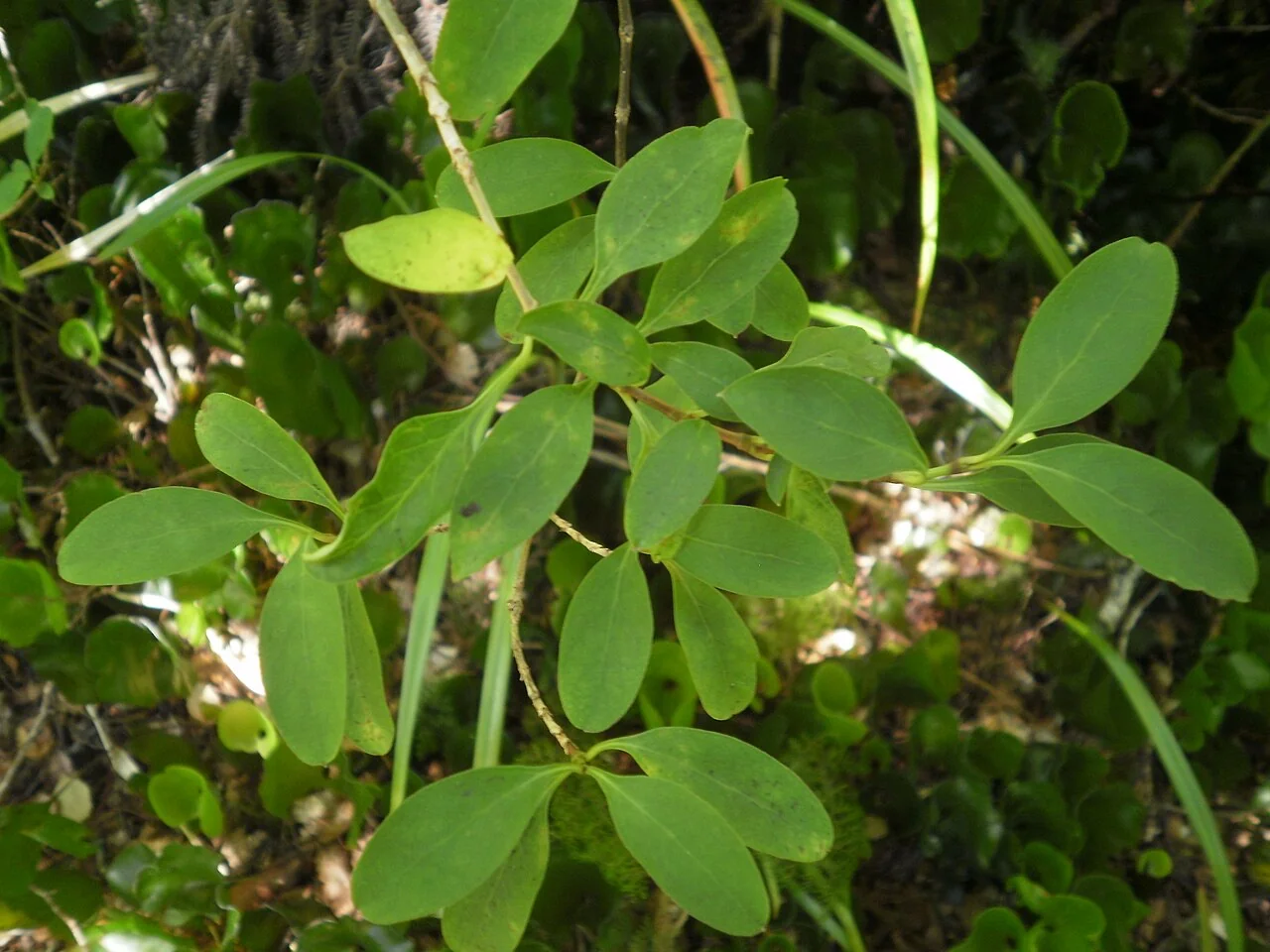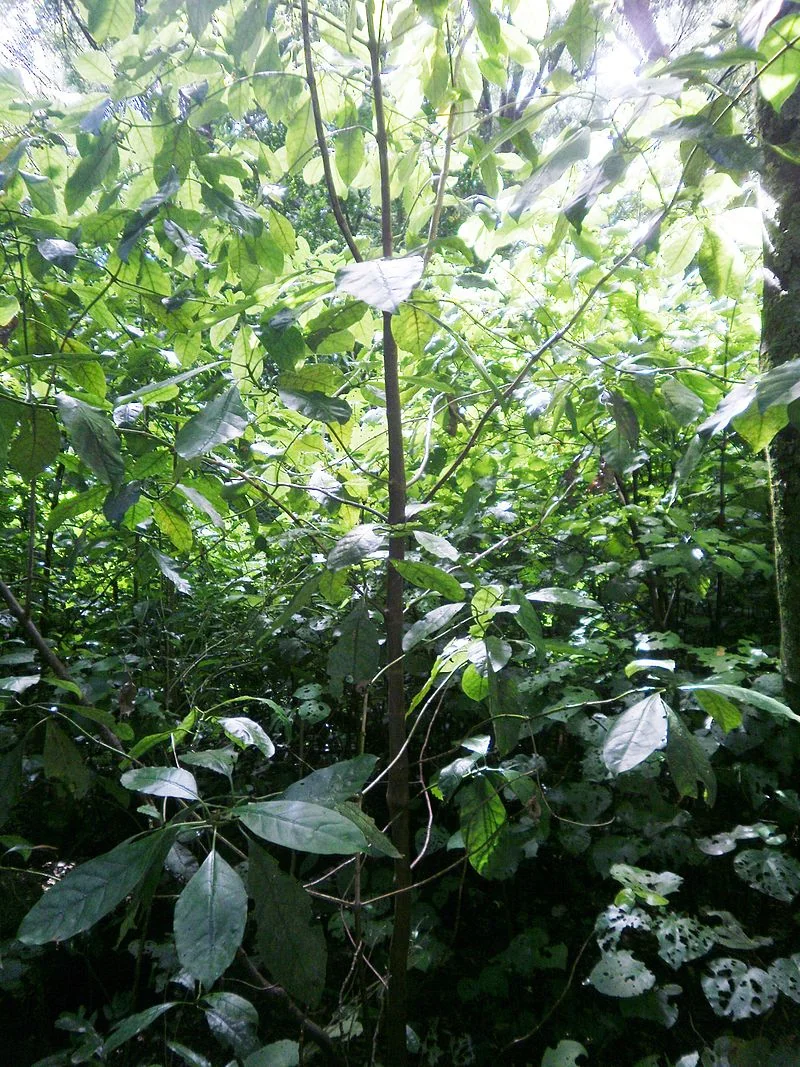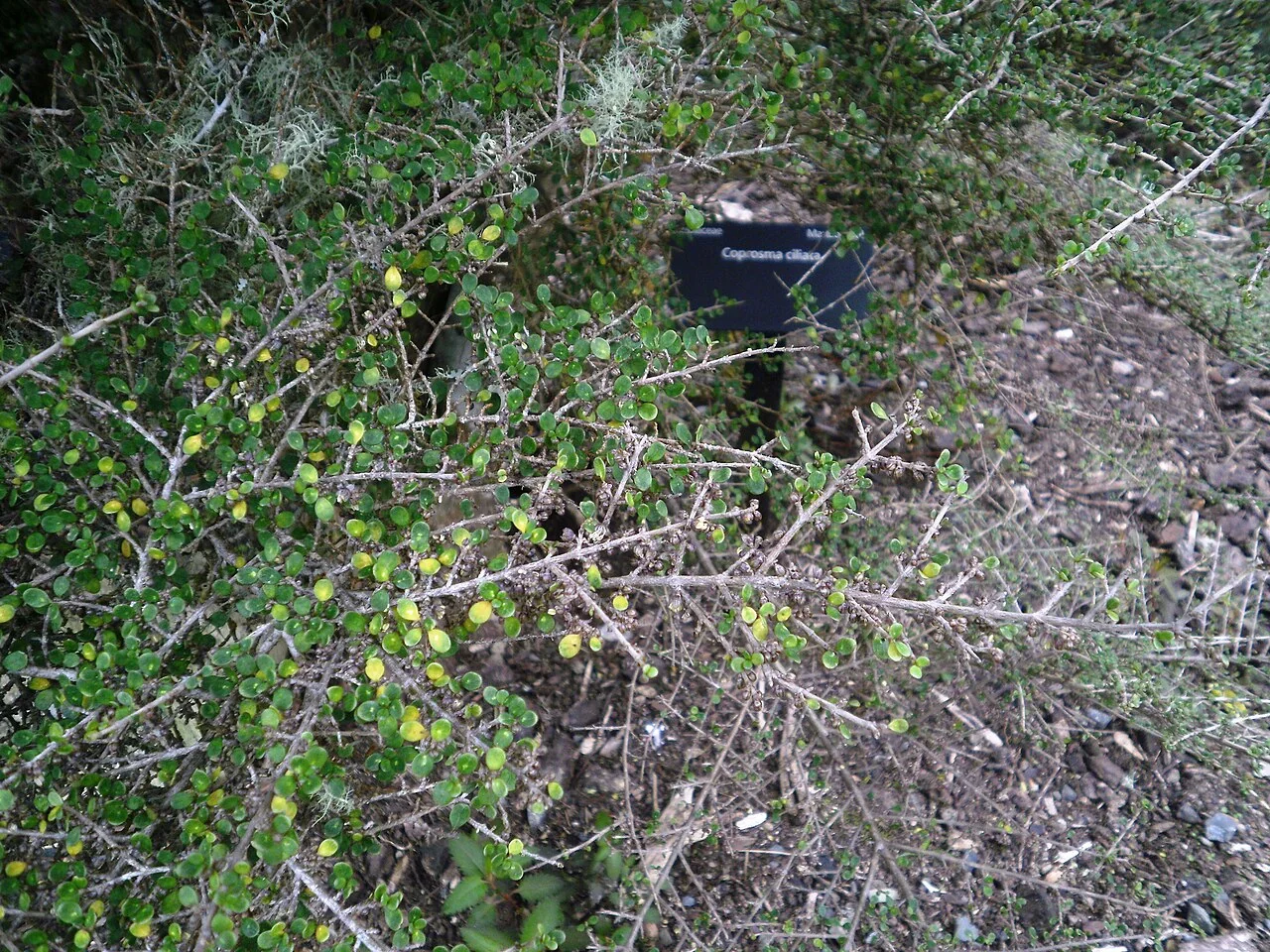
Hairy Coprosma
Coprosma ciliata
Coprosma ciliata is a bushy shrub among New Zealand's native shrubs endemic to New Zealand, typically growing up to 3 meters tall. It is characterized by its wide-angled, slender branches and branchlets that are often pubescent (hairy). Its leaves are a distinctive feature, giving the species its name. They are small, thin, and range from broad-ovate to oval to oblong, measuring about 6-20 mm long and 1.5-10 mm wide. The leaves have small hairs along their margins (cilia) and often underneath, with 1 or 2 pits on the underside. Coprosma ciliata produces solitary, axillary flowers. The fruit is a globose to oblong drupe, approximately 6-7 mm in diameter, and can be white, yellow, orange, pink, or purplish-red. This hardy species is found in the South Island of New Zealand, from Lake Brunner southwards into Fiordland, primarily west of the Southern Alps. It thrives in lowland to higher montane forests and grasslands, from 0-900 meters elevation, often growing beside streams, swamps, and lakes.

Plant Description
Botanical Features
Coprosma ciliata , commonly known as Hairy Coprosma, is a variable, bushy evergreen shrub endemic to New Zealand, typically growing up to 3 meters tall. It is distinguished by its small, oval leaves that have characteristic hairy edges (cilia), giving the species its name. The leaves are thin, longer than wide, and often have one or two pits on their underside. The plant produces solitary, axillary flowers, followed by globose to oblong drupes (berries) approximately 6-7 mm in diameter, which can range in colour from white, yellow, or orange to pink or purplish-red. It is found in lowland to higher montane areas across New Zealand, thriving in cool, moist climates with good drainage and tolerant of harsh mountain conditions.
Quick Facts
| Scientific Name | Coprosma Ciliata |
|---|---|
| Height | 1-2 m |
| Spread | 1-1.5 m |
| Water Needs | Low |
| Light | Full sun |
| Frost Tolerance | Excellent |
| Salt Tolerance | Poor |
| Growth Rate | Slow to moderate |
| Lifespan | Long |
Climate Best Suited to
Coprosma ciliata thrives in cool, moist conditions typical of New Zealand's native forests. Prefers sheltered positions with consistent moisture. It adapts well to typical New Zealand growing conditions with appropriate care and positioning.
Regional Suitability
| Whangārei | Ideal |
| Auckland | Ideal |
| Hamilton | Suitable |
| Rotorua | Suitable |
| Tauranga | Ideal |
| Gisborne | Ideal |
| New Plymouth | Ideal |
| Whanganui | Ideal |
| Palmerston North | Suitable |
| Napier | Ideal |
| Wellington | Ideal |
| Nelson | Ideal |
| Christchurch | Suitable |
| Dunedin | Suitable |
| Invercargill | Suitable |
| City | Climate Suitability |
|---|
Natural Habitat
Typical Environments
Hairy Coprosma ( Coprosma ciliata ) is endemic to New Zealand and is found in a variety of habitats across the country, ranging from lowland to higher montane areas, typically between 0 and 900 meters, and sometimes up to 2000 meters in montane and subalpine regions. It grows in forests and grasslands. While found throughout New Zealand, it is more localized except in the southern parts of its range, including the North, South, Stewart, Auckland, Campbell, and Antipodes Islands, extending from the Tararua Range southwards. In the South Island, it is particularly prevalent from Lake Brunner south into Fiordland, primarily west of the Southern Alps, often found near streams, swamps, and lakes in lowland forests. It is also well-adapted to the remote and challenging environments of subantarctic islands. This species is well-adapted to cool, moist climates with good drainage, tolerating harsh conditions such as strong winds, temperature extremes, and snow. It prefers well-drained mountain soils and cannot withstand waterlogged conditions.
Plant Conservation
Coprosma ciliata is a widespread and common species throughout its range in New Zealand. There is no specific conservation threat classification for Coprosma ciliata , and it is generally considered 'Not Threatened'. However, like all native species, its habitats can be impacted by human activities such as land development and the spread of invasive species. Conservation efforts focus on protecting its natural habitats and promoting its use in restoration projects to maintain biodiversity.
Growing Requirements
Soil Requirements
Coprosma ciliata ( Coprosma ciliata ) performs best in well-draining soil that retains adequate moisture. Like most New Zealand natives, it prefers soils that don't become waterlogged but maintain consistent moisture levels. Good drainage is essential for healthy root development.
- Well-draining soil essential for healthy growth
- Prefers consistent moisture without waterlogging
- Adapts to various soil types with good drainage
- Benefits from organic matter incorporation
- Mulching helps retain moisture and suppress weeds
Light Requirements
Coprosma ciliata ( Coprosma ciliata ) performs well in full sun to partial shade conditions. Like many New Zealand natives, it adapts to various light conditions but typically shows best growth and form in positions that receive adequate sunlight throughout the day.
- Full sun to partial shade positions
- At least 4-6 hours of direct sunlight daily
- Tolerates light shade in warmer climates
- Morning sun particularly beneficial
Water Requirements
Coprosma ciliata ( Coprosma ciliata ) requires regular watering during establishment, typically for the first 1-2 years. Once established, it becomes more drought-tolerant but benefits from consistent moisture during dry periods. Avoid overwatering which can lead to root problems.
- Regular watering during establishment phase
- Moderate drought tolerance once established
- Consistent moisture during dry periods beneficial
- Avoid waterlogged conditions
- Mulching helps conserve soil moisture
Planting Guide
When to Plant
The best time to plant Hairy Coprosma ( Coprosma ciliata ) is during spring, when soil temperatures are warming and there is consistent moisture. It can also be planted in summer, provided adequate watering is maintained during dry periods to aid establishment.
How to Plant
Choose a site that receives full sun to partial shade, as full sun encourages the best berry production and more intense foliage colour. Ensure the location offers excellent drainage, as this species cannot tolerate waterlogged conditions. It is highly frost-tolerant and can withstand strong winds, making it suitable for exposed mountain conditions. Dig a hole twice as wide and to the same depth as the plant's root ball. Gently remove the shrub from its container, tease out the roots, and cut away any circled or tangled roots. Position the plant in the hole so the top of the root ball is level with the surrounding ground. Backfill with soil, gently firming it down. Form a raised, doughnut-shaped ring of soil around the outer edge of the plant's root zone to help retain water. Water in well immediately after planting to settle the soil around the roots. Mulching around the base will help retain soil moisture and suppress weeds.
Ecological Role
Environmental Benefits
Coprosma ciliata , also known as Hairy-edged Coprosma, plays a crucial ecological role within New Zealand's subantarctic island and montane ecosystems. This native shrub is found in a variety of habitats, including forests and grasslands, from lowland to higher montane areas, and up to 2000 meters in elevation.
- Wildlife Nutrition: The plant produces large, colourful drupes (berries) that serve as an essential food source for seabirds and mountain birds, particularly during important seasonal periods.
- Habitat Provision: The dense, branching structure of Coprosma ciliata offers shelter and nesting sites for small birds and invertebrates, especially in exposed environments.
- Soil Stabilization: With its extensive root systems, Coprosma ciliata helps to prevent erosion on steep mountain slopes and unstable terrain.
- Seed Dispersal: The fleshy fruits are consumed by animals, which then aid in the dispersal of its seeds through frugivory.
- Adaptation to Harsh Environments: Coprosma ciliata exhibits specialized adaptations to its challenging, wind-swept habitats, such as hairy leaf margins and pubescent surfaces that help reduce moisture loss and provide protection from strong winds.
- Genetic Diversity: It is also known to hybridize with other Coprosma species, contributing to the genetic diversity of the genus.
Uses and Significance
Garden Uses
- Excellent for native plant gardens and restoration
- Suitable for naturalistic landscape designs
- Low maintenance once established
- Contributes to local biodiversity
- Attractive to beneficial native wildlife
Cultural Significance
Traditional Uses and Values
Hairy Coprosma ( Coprosma ciliata ) holds cultural significance as part of the diverse Coprosma family, many species of which were traditionally used by Māori for various purposes, including medicinal applications (rongoā) and as food sources. Its presence in forest ecosystems also contributes to traditional ecological knowledge, highlighting the interconnectedness of native flora and fauna.
Landscaping Applications
Hairy Coprosma ( Coprosma ciliata ) is a versatile native New Zealand shrub with several landscaping applications, particularly valued for its hardiness and distinctive features. Its evergreen nature and tolerance for harsh conditions make it a valuable addition to various garden designs:
- Alpine and Rock Gardens: An ideal choice for specialized rock gardens and alpine plant collections due to its compact form, unique foliage, and ability to thrive in harsh mountain conditions. It can be a centerpiece for authentic New Zealand mountain garden themes.
- Challenging Environments: Well-suited for difficult garden situations where other plants might struggle, as it tolerates strong winds, extreme temperatures, and snow.
- Year-Round Interest: Its compact growth habit and consistent production of bright orange to red berries provide visual appeal throughout the year.
- Wildlife Support: The large, colourful berries serve as a crucial food source for seabirds and mountain birds. Its dense, branching structure also offers shelter and nesting sites for small birds and invertebrates.
- Erosion Control: With its extensive root system, Coprosma ciliata can help stabilize soil and prevent erosion on steep slopes and banks.
- Collector's Gardens: Highly valued by plant enthusiasts for its distinctive hairy-edged leaves, adding a unique textural element.
- Hedging and Pioneer Plantings: While other Coprosma species are more commonly used for hedging, C. ciliata can form a tight mound in exposed areas, suggesting its potential for low hedging. It is also suitable for pioneer and riparian plantings.
Seasonal Care Calendar
Spring
Spring is an active growth period for Coprosma ciliata ( Coprosma ciliata ). New growth emerges and this is an ideal time for planting new specimens. Monitor soil moisture as temperatures warm and growth accelerates.
- Active growth period with new foliage development
- Ideal time for planting new specimens
- Monitor soil moisture as temperatures rise
- Apply organic mulch if needed
Summer
Summer is typically the main growing season for Coprosma ciliata ( Coprosma ciliata ). Ensure adequate watering during hot, dry periods, especially for young plants. Established plants show good heat tolerance with appropriate care.
- Peak growing season with active development
- Monitor watering needs during hot weather
- Young plants need consistent moisture
- Established plants show good heat tolerance
Autumn
During autumn, Coprosma ciliata ( Coprosma ciliata ) begins to slow its growth as temperatures cool. This is another good time for planting as conditions become more favorable. Reduce watering frequency but maintain soil moisture.
- Growth slows as temperatures moderate
- Good time for planting new specimens
- Reduce watering frequency gradually
- Maintain soil moisture without overwatering
Winter
Winter is typically a dormant period for Coprosma ciliata ( Coprosma ciliata ), with minimal growth activity. Reduce watering but ensure plants don't completely dry out. Most New Zealand natives are cold-hardy and require minimal winter protection.
- Dormant period with minimal growth activity
- Reduce watering but avoid complete drying
- Generally cold-hardy in most New Zealand climates
- Minimal winter protection required
When to Prune and How Much
Coprosma ciliata ( Coprosma ciliata ) generally requires minimal pruning to maintain its natural form and health. Most maintenance involves removing dead or damaged growth and light shaping if needed.
- Remove dead, damaged, or diseased growth as needed
- Light pruning to maintain shape if desired
- Prune after flowering if applicable
- Avoid heavy pruning which can stress the plant
- Use clean, sharp tools to prevent disease
- Most natives maintain good form without regular pruning
Always use clean, sharp tools when pruning to minimize disease risk. Native plants typically maintain their natural form well and often require less intervention than exotic species.
How to Grow Hairy Coprosma
From Fresh Berries
Fresh berry propagation represents the most reliable and natural method for growing Hairy Coprosma, taking advantage of this mountain species' excellent seed production and natural frugivory dispersal strategy that has evolved over thousands of years in New Zealand's challenging alpine environments. This hardy South Island endemic produces abundant orange globose berries during February to May that provide exceptional opportunities for propagation while supporting the species' natural regeneration cycles in montane forest and grassland communities. The species' adaptation to harsh mountain conditions from sea level to 900 meters elevation makes it particularly valuable for restoration projects and alpine gardens that require resilient native plants capable of withstanding frost, wind, and variable moisture conditions. Fresh berries yield significantly higher germination success compared to stored seeds, making immediate processing and sowing the preferred approach for both conservation propagation and garden cultivation of this distinctive hairy-leaved coprosma. Collect ripe berries during autumn when they have achieved their characteristic orange coloration and can be easily removed from branches, timing collection to coincide with peak ripeness when seeds have reached maximum viability for successful establishment. Choose berries that are fully developed, firm, and show the distinctive orange coloration typical of mature fruit, avoiding any that appear damaged, diseased, or prematurely dropped which might indicate compromised seed quality or poor genetic material. Process berries immediately after collection by removing all flesh through thorough washing, using gentle rubbing under running water to separate seeds from fruit material that could inhibit germination or promote fungal growth during the critical establishment period. Clean seeds by repeated washing until all fruit debris is removed, retaining the small dark seeds that settle to the bottom while discarding floating material that typically indicates poor viability or damaged seeds unsuitable for propagation. Prepare optimal germination medium using well-draining seed-raising mix with good moisture retention characteristics, ensuring pH levels between 6.0-7.0 that support healthy development for this montane forest species adapted to well-drained mountain soils. Sow fresh seeds immediately after processing, placing them on the surface of moist growing medium or covering lightly with 2-3mm of fine sand, as they benefit from some light exposure during germination while requiring protection from drying out that can quickly kill developing embryos. Provide optimal environmental conditions including consistent temperatures between 15-20°C and bright, indirect light that replicates the filtered forest conditions where this species naturally establishes in mountain forest understory and edge environments. Maintain careful moisture management throughout the 4-8 week germination period, ensuring growing medium remains consistently moist but never waterlogged while monitoring for early emergence signs that indicate successful seed activation. Young seedlings develop at moderate rates while establishing the root systems necessary for adaptation to mountain growing conditions, requiring protection from direct sunlight and environmental stress during early establishment phases before transplanting to permanent locations. Transplant successful seedlings when they reach 3-5cm height and have developed sufficient root systems to handle garden conditions, providing growing environments that support transition from nursery to permanent mountain garden locations where they can contribute to native alpine plant communities.
From Semi-Hardwood Cuttings
Semi-hardwood cutting propagation offers a reliable vegetative method for growing Hairy Coprosma that preserves the exact genetic characteristics of superior parent plants while providing consistent results for experienced propagators working with alpine native plant cultivation and mountain restoration projects. This approach is particularly valuable for maintaining exceptional specimens that demonstrate superior adaptation to specific mountain conditions, enhanced cold tolerance, or other desirable traits that can be preserved through careful vegetative propagation techniques suited to this hardy South Island endemic. The method works especially well with Hairy Coprosma because of this species' natural ability to develop adventitious roots under appropriate growing conditions, making it suitable for both commercial alpine nursery production and conservation breeding programs focused on maintaining genetic diversity. Take semi-hardwood cuttings during late summer to early autumn when current season's growth has achieved optimal maturity for rooting while retaining sufficient vigor for successful establishment under controlled mountain propagation environments. Select healthy, vigorous shoots from the middle portions of branches that display the characteristic hairy-edged leaves and robust mountain growth typical of healthy Hairy Coprosma development, avoiding both very soft growth and completely hardened wood that may resist rooting. Cut sections 8-12cm in length with clean, sharp secateurs, ensuring each cutting includes at least 2-3 nodes while selecting material that represents the best characteristics of the parent plant including compact growth habit and the distinctive ciliate leaf margins that characterize this species. Remove lower leaves carefully to reduce transpiration stress while retaining sufficient photosynthetic capacity in upper leaves, taking care not to damage the distinctive hairy-edged foliage that provides energy for root development during the establishment period. Apply rooting hormone powder or solution immediately after preparation, using formulations appropriate for semi-hardwood native species to enhance root initiation while ensuring even coverage of cut surfaces where new root systems will develop for mountain conditions. Insert prepared cuttings into well-draining cutting mix composed of equal parts quality propagation medium and coarse sand or pumice, ensuring excellent drainage while maintaining the consistent moisture levels essential for successful root development without creating waterlogged conditions that can damage mountain species. Maintain optimal environmental conditions including high humidity (75-85%) and consistent temperatures around 18-20°C using humidity domes, misting systems, or controlled environment facilities that support root development while preventing cutting stress typical of mountain species propagation. Provide bright, indirect light that supports photosynthesis without causing excessive transpiration stress, replicating the filtered light conditions where this species naturally thrives in mountain forest understory and grassland edge environments. Monitor cutting development throughout the 6-10 week rooting period, maintaining consistent environmental conditions while watching for signs of successful root development including new shoot growth and resistance when gently tested for root establishment. Root development occurs gradually as cuttings establish the fibrous root systems characteristic of mature Hairy Coprosma plants adapted to mountain soils, requiring patience and consistent care throughout the establishment process typical of alpine species. This method provides excellent results for maintaining specific genetic lines while contributing to conservation efforts that preserve the natural variation essential for healthy native plant populations in mountain restoration and specialized alpine landscape applications.
From Mountain Habitat Restoration
Mountain habitat restoration establishment provides a comprehensive approach to growing Hairy Coprosma that focuses on recreating authentic montane forest and grassland ecosystems while contributing to landscape-scale conservation efforts and alpine biodiversity enhancement. This method is particularly valuable for restoration projects that aim to reestablish the diverse plant communities where this species plays important ecological roles as both wildlife food source through its orange berries and structural component of mountain forest understory from lowland to montane elevations. Hairy Coprosma serves as an excellent indicator species for healthy mountain ecosystems, thriving in diverse habitats from sea level wet forests to 900-meter alpine grasslands that challenge many other native species. Begin by identifying suitable restoration sites that provide the environmental conditions typical of this species' natural habitat, including areas with good drainage, protection from extreme wind exposure, and soil conditions that support diverse mountain plant community development across elevation gradients. Design restoration plantings that incorporate Hairy Coprosma as part of authentic mountain forest understory communities, combining it with appropriate companion species such as other native mountain shrubs, alpine grasses, and subalpine plants to create realistic ecosystem relationships that reflect natural plant associations. Source plant material through a combination of locally-adapted seedlings, fresh berry propagation, and cutting-grown specimens to ensure genetic diversity and adaptation to local mountain environmental conditions that support long-term ecosystem establishment success across varying elevation zones. Prepare restoration sites by removing invasive vegetation, improving soil conditions through organic matter incorporation, and creating diverse microhabitat conditions that accommodate the varied requirements of mountain plant communities adapted to challenging alpine conditions. Establish initial plantings during optimal seasonal windows in autumn or spring when environmental conditions support rapid establishment before plants face stress from summer heat or harsh winter mountain weather that can challenge even hardy native species. Space plantings according to natural mountain forest development patterns, with appropriate density to encourage natural understory development while allowing room for plant growth and natural regeneration processes typical of montane ecosystem succession over time. Create diverse habitat structure by varying planting positions according to moisture gradients, wind exposure, and elevation conditions that replicate the natural environmental variation found in healthy mountain forest and grassland ecosystems where this species naturally thrives. Integrate with complementary native species that historically occurred in montane forests and grasslands, creating plant communities that provide enhanced wildlife habitat, erosion control on steep mountain slopes, and authentic ecosystem functions including nutrient cycling and soil stabilization essential for mountain environment stability. Monitor establishment success and provide appropriate maintenance including selective weed control, supplemental watering during establishment periods, and protection from browsing animals that could damage developing mountain forest communities vulnerable during early establishment phases. Allow natural ecological processes including seed dispersal by frugivorous birds, natural regeneration, and mountain succession to enhance initial plantings, creating dynamic restoration sites that evolve over time while maintaining the essential ecological functions that Hairy Coprosma provides in authentic New Zealand mountain ecosystems. This approach requires sustained commitment and adaptive management compared to individual plant cultivation, but creates resilient and self-sustaining mountain ecosystems that provide lasting environmental benefits including wildlife habitat, erosion control, and authentic alpine landscape restoration that supports native biodiversity conservation across elevation gradients.
Pests and Diseases
Common Pests
Hairy Coprosma ( Coprosma ciliata ) can be affected by several pests. Scale insects may occasionally infest leaves and stems, potentially reducing plant vigor. Aphids can colonize new growth, leading to curled leaves and stunted development. The Coprosma white erineum mite ( Phyllocoptes coprosmae ), an endemic gall mite, causes white, hairy growths on the underside of the leaves, though it is generally not considered a significant threat. Thrips, both native and exotic species, can damage plants by sucking plant juices and scraping at leaves. Herbivorous animals also pose a threat through browsing, and Coprosma species have evolved adaptations to protect themselves from such predation.
Disease Prevention
Native rust is a common fungal disease that causes pale yellow spots on the underside of leaves, eventually turning brown. While it causes leaf spots, it is not known to inflict significant long-term harm. Leaf spot diseases, often identified as Mycosphaerella coacervata or Phyllosticta coprosmae , can manifest as purple blotches on leaves. Root rot is a common issue resulting from waterlogged soils or poor drainage. To prevent diseases, ensure plants are grown in well-ventilated areas with excellent soil drainage. Regular inspection for early signs of disease, prompt removal of affected plant material, and maintaining overall plant health through proper care can significantly reduce the risk of serious outbreaks. Using clean tools for pruning also helps prevent the spread of pathogens.
Bonus Tip
Expert Growing Advice
Plant both male and female specimens to enjoy the vibrant berries. Hairy Coprosma ( Coprosma ciliata ) is a dioecious species, meaning individual plants are either male or female. To ensure the production of its attractive orange to red berries, which are a key ornamental feature and a food source for native birds, you will need to grow both male and female plants in proximity. The female plants will produce berries only when a male plant is nearby for pollination.


